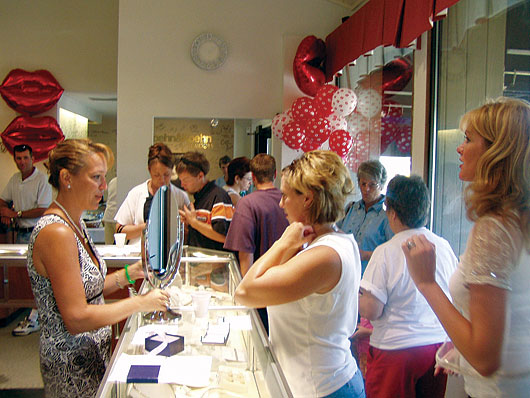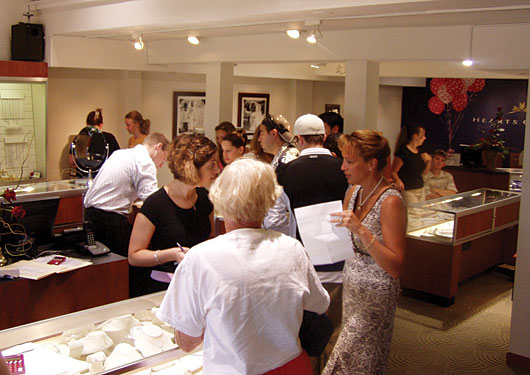Scared of irking your customers with phone calls? So was Andy Koehn

[h3]Best info: Koehn & Koehn Jewelers[/h3]
Address: 2415 West Washington Street, West Bend, WI 53095
Phone: (262) 338-1600
URL: koehnjewelry.com

[dropcap cap=A]ndy Koehn keenly remembers the unease he felt when the consultants he’d just hired suggested he call up his entire customer list to promote a sales event. “I was like, sure, I’m really going to do this, alienate my best customers.
“We thought they’d be mad. I’ve been called myself and like everybody have been annoyed by (telemarketers).”
Advertisement
But the owner of Koehn & Koehn Jewelers in West Bend, WI, having agreed to pay for the marketing advice, set his reservations aside and plunged in — to the shallow end. He called most but not all of his customers.
Time proved his fears were misplaced. The event was a success: Wall-to-wall customers, who had a great time and bought a substantial amount of jewelry.
“We actually made a lot of customers angry because we didn’t call them. I met people on the street later and they were like, ‘Thanks a lot, why didn’t you invite us? What is it, we’re not good enough to be invited?’ I was pretty surprised. I realized we could do this.”[/dropcap]
That was four years ago and the once-a-year events, which go by the name “Kiss and Tell,” continue to get bigger and better. The last, held in May, generated a six-figure sum in sales — more than 5% of Koehn & Koehn’s annual turnover.
The campaigns have transformed the way Koehn thinks about retailing: Primarily, that it is okay to be more assertive in trying to drive traffic into your store.
“It has changed the idea (of how it works), of getting a store, stocking it, training staff and then waiting for things to happen. You do have a lot of control about how much traffic you can generate,” he says.
Advertisement
To be sure, Koehn’s sales campaigns aren’t hard sell, nor are the calls made to “cold” customers. “We tell our customers we are having a party and ask them to come along.”
Most of the people reached on the phone turn out to be indifferent, he says. A handful — no more than five of the 3,000 called in May — made it known they were unhappy at being contacted. Those who did come along had a good time and told their friends about it.
“They’re getting a call from their jeweler. It makes them feel special,” Koehn says.
Ronald Bill, chief executive of Premier Consulting Innovations (PCI), the Indianapolis, IN-based company that helped Koehn organize the sales event, says the telephone calls are the key to making the day a success.
“What is interesting is that we can predict very closely what the revenue will be if you follow our guidelines. It nearly always works out to be about four appointments from every 100 calls, and from those four contacts, one sale.”
In the six weeks ahead of the “party,” PCI provides a four-hour training session and weekly reviews to get the staff ready. The training includes role-playing, tips on how to make telephone calls and other advice on handling customers, as well as motivational talks to energize the staff.
Advertisement
“It’s about having people executing properly. Having them realize it’s not a bad thing to use the phone, to have telephone touches. The whole behavior of the sales person changes,” says Bill.

Importantly, PCI also provides follow-up to make sure sales assistants actually put through the calls they were assigned to make. “A big part of this is providing accountability,” he says. “The sales staff are accountable to us and the store owner.”
Once the calls are made, postcards are sent out as reminders, decorations stuck up (in Koehn & Koehn’s case, big inflatable lip balloons in line with the theme), champagne is stocked, and caterers brought in. Apart from the calls and the postcard mail-out there is no advertising. This is to enforce the impression that it is an exclusive client-only event.
With all the preparations in place, Koehn then needs to deliver on the promise of a special occasion — and special price breaks.
“That is what the customer is really interested in,” he says, adding however that he and his staff are careful to never use the word “sale.” “That’s prohibited. It takes any sort of edge off it. Everybody has “sales.’ “
Koehn makes all his pricing decisions on the day, depending on how many customers are in the store, how long the item has been on the books, if he likes the item, and whether he particularly likes the customer.
“Nobody, including me, knows what the markdown is going to be. We tell them that flat out, these will be lowest prices all year, but everything depends on what happens on the day.
“I have a printout [of all the stock]. I look at it. If the piece has been with us for over a year it gets a nice fat kiss, and big price cut. The middle ones, I’ll consider what the turn is likely to be through the year, and the cost of replacing it.”
With so many people in the store, Koehn says there’s a risk of slipping into “greed mode.” “You need to remind yourself to do right by the customer. The markdowns need to be enough to reward them for coming in. This is the one day when a lower margin is justified and acceptable from a business standpoint,” he says.
Koehn concedes that such sales parties aren’t particularly uncommon in the jewelry industry and that in theory he should have been able to do the organization and train his staff without outside help.
“I’ve told other people (in the industry), just do it.”
“But it’s a strange thing. You won’t do it until you part with money. It’s the equivalent of hiring a personal trainer. You go to the gym, you know what you gotta do — But somehow when you pay the money, the results are much quicker and more effective. It will keep you from getting lazy.”
Similarly, his salespeople are more receptive to outside advice.
“You bring someone in from 30 miles away and they’re an expert. The store owner standing up front is one thing. But if I say he’s from PCI, we’re going to have an event, and the sales people will listen. They have more credibility.”
Koehn says his experience with the telephone-supported events is that they are they best trade-off for his marketing money because they allow the retailer to personally connect with his prospects.
“You take out a full page ad in the newspaper for $3,000 and two people will come in the door. This way, you get a store full of people from opening to close.”
“Using the word telemarketing strikes fear in everybody … But it started the ball rolling. We’re now very comfortable with doing follow-up calls to a prospect. Sometimes you’ll spend two hours with a customer, and they say they want time to think about it, and they get out the door. You then spend many days thinking, is he going to come back? Are you going to get the sale? So now we just say, ‘Do you mind if I follow up with you?’ And they don’t. It’s not a big deal. It’s just follow-up call.”
Similarly important is the way a more active approach to retailing empowers the sales staff, he says. It’s telling them that they are professionals and that they have more than a “clerk’s job.”
“You’re giving power to the seller in your store. You are taking control.”
[span class=note]This story is from the July 2006 edition of INSTORE[/span]